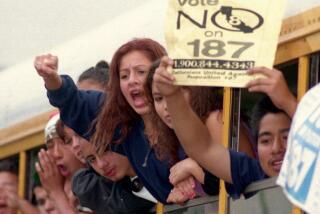The Electoral Landscape Is Changing Dramatically
- Share via
Allegations of voting fraud in the 46th Congressional District are being sorted out, but regardless of the results, Orange County is dealing with a profoundly altered electoral landscape for the long term. Statistics provided by the California Department of Finance show that Orange County will have a white population below 50% in 2023, and that Santa Ana already has the highest concentration of minorities--some 77%--while cities like Stanton, La Palma, Garden Grove and Anaheim currently have percentages in the 40s. While Orange County does have three cities that are at least 90% white, the old perceptions and stereotypes of Orange County as a white enclave have been changing.
This past November’s election victory by Democrat Loretta Sanchez, who upset longtime Republican Rep. Robert K. Dornan, was a dramatic illustration of the potential impact of increased participation in politics by minorities. Along these lines, a recently published book by Stanford University professor Dale Maharidge looked at demographics, politics and race relations in Orange County as well as in the state. Maharidge suggests that a profound political change is underway, with the largest showing ever by nonwhites in the November election, and an effect on what he terms an “island mentality” of class divisions.
Maharidge predicts that people like Sanchez, who embrace changes brought on by immigration, will have a significant political impact on the county in the future. This idea was supported by the chairman of Sanchez’s successful campaign, lawyer Wylie A. Aitken, who says that “we recognized that those who don’t open their arms and welcome everybody in, and remember what this country is all about, are going to suffer for that.”
That is a partisan point of view, to be sure, since it is not as if Republicans in Orange County have been unaware of the importance of the immigrant vote. It was not so long ago that former Supervisor Gaddi H. Vasquez addressed the Republican National Convention and argued that it was the Republicans who were most in step with the immigrants. Vasquez ran afoul of his own county’s fiscal disaster, the bankruptcy, and the great things that were predicted for him never materialized.
But the degree to which immigrant participation in the process is encouraged and realized has a profound effect on our politics. In the past, political contests have been affected by low minority turnout. The Orange County Annual Survey as recently as 1995 found that a high percentage of Asian adults, 47%, and of Latinos, 50%, had never voted.
In the last couple of years, questions have been raised about how much room there really is under the Republican tent because of battles over benefits for immigrants, affirmative action and the like. This has given the impression that the party is not really the friend of new immigrant groups. For example, columnist Paul Gigot of the Wall Street Journal now says “I told you so,” because he and some other conservatives argued early on that immigrant bashing would backfire and drive the new voters away from the GOP.
Large numbers of such voters, as well as future turnout, clearly will decide much about the nature of political representation from Orange County. In the campaign seasons ahead, the old verities about how elections are won in this bastion of conservatism will be put to the test.
It is easy enough to predict a big change ahead, as the Stanford researcher has done. But how that all plays out in future elections is very much up in the air. The changes in the ethnic political foundation of the county offer challenges to both major parties, which had been accustomed to familiar electoral patterns.
The entrepreneurial spirit espoused by Republicans offers a potentially attractive and positive way to go about enlisting immigrant support, instead of allowing the voices of nativism and immigrant bashing to hold sway. The Democrats have learned about mobilizing the immigrants, but they have their own pitfalls to work out, as is evident in the national controversy over campaign contributions.
It will be good for everybody, and for the vitality of our politics and government, if both parties locally can respond with creative and broad ideas and appeals to the new voters.
More to Read
Get the L.A. Times Politics newsletter
Deeply reported insights into legislation, politics and policy from Sacramento, Washington and beyond. In your inbox twice per week.
You may occasionally receive promotional content from the Los Angeles Times.










